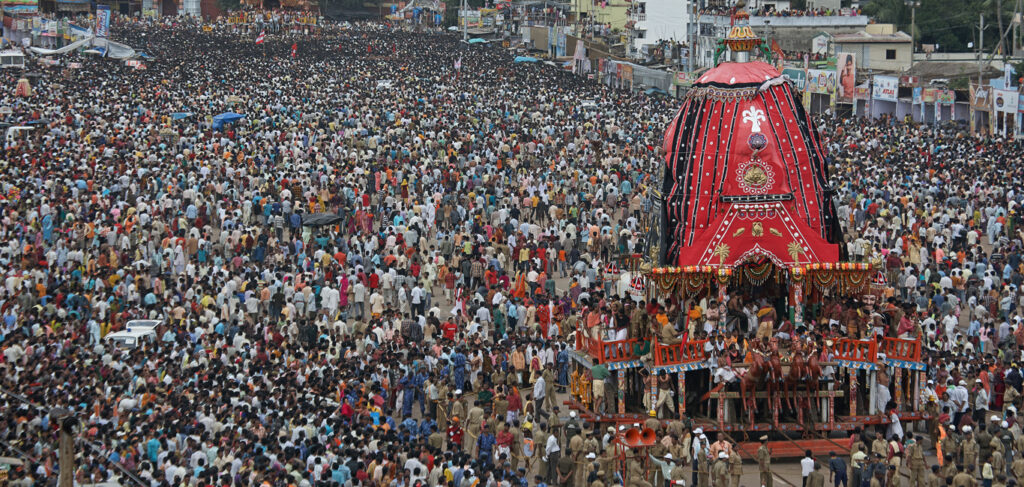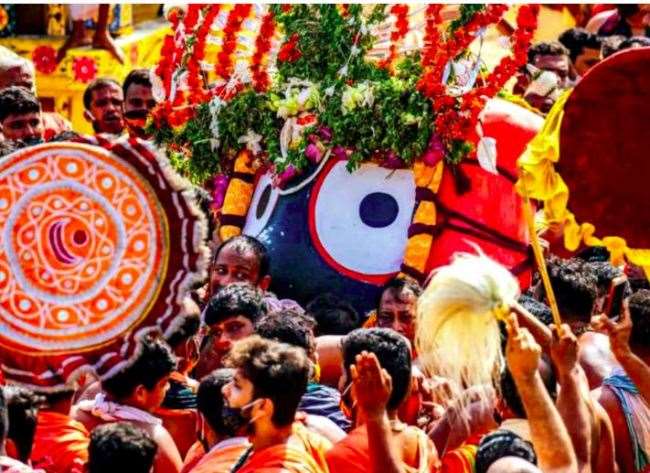Did you know that the Rathayatra of Puri contributed a new word to the English language? The grand chariot festival will take place on July 1 this year.
There is a huge roar from the crowd when the servitors arrives at the temple’s entrance carrying the enormous wooden idol of Lord Jagannath. As if bringing the enormous, heavy idol from the temple to the chariot wasn’t difficult enough, hundreds of people rushed the idol, trying to touch it or rip off a piece of the floral headdress as a gift. For the Rathayatra festival, also known as the grand chariot festival, the historic city of Puri is Odisha’s most well-known seaside town.
The older brother and younger sister, Balabhadra and Subhadra, were already seated on their respective chariots. Now it was Jagannath’s time (the Lord of the Universe). To get the idols into the chariots, which were elegantly painted with little wooden figurines and covered in cloth showing the appliqué craftsmanship of Pipili, a town close to Puri, the servitors had a difficult time hauling and pushing the idols up a ramp.
The varied traits of each chariot might be used to identify them. The Taladwaja, or Balabhadra’s chariot, was 44 feet tall, covered in crimson and green cloth, and had 14 wheels. The 43-foot-tall Darpadalan, which had 12 wheels and was wrapped in scarlet and black cloth, served as Subhadra’s chariot. Nandighosh, Jagananth’s chariot, was 45 feet high, had 16 wheels, and was wrapped in crimson and yellow cloth. The British came up with the term “juggernaut,” which means “unstoppable power,” after being mesmerised by the sight of this gigantic chariot rolling on its enormous wheels while being driven by the pilgrims.
Every year, the three chariots are completely rebuilt. The chariots were lined up next to the Arun Stambha in front of the Singha Dwar (Lion Gate) of the temple on the day before the festival, with coils of strong ropes fastened to the axles.
Every time someone travels to see Rathayatra, they will notice the crowds are like a river in flood. The local Vaishnav mutts sang kirtans, dressed Odissi dancers and acrobats put on spontaneous displays, and pilgrims pushed forward while raising their hands to the sky and singing the Lord’s name. Indian and foreign photographers and journalist are mostly present to witness and capture photographs and videos of this amazing festival.
Two perspectives exist about the festival. Either you go the safe route and get a ticket for a seat in the galleries built close to where the chariots’ trip began. Or, you may just get lost in the sea of pedestrians crossing the Bada Danda, or Grand Road, in front of the Gundicha Shrine, a 12th-century temple, where the gods will be travelling in three chariots to their aunt’s home. I went with the latter.
The origins of the Jagannath religion are steeped in myth. According to legend, Viswabasu, a Shabar tribal leader, was secretly worshipping the idol of Nilmadhav until King Indradyumna of Malwa sent a Brahmin priest named Vidyapati to find it. Vidyapati eventually managed to locate the idol and ended up being married to the chieftain’s daughter. The idol, however, vanished on its own. A new wooden idol was to be created, according to divine instructions given to King Indradyumna. Since that time, Puri, also known as the Shree-kshetra, has become a centre for worship of Lord Jagannath and his siblings.
The imposing idols are revered within the temple and carried outside during the Snanyatra, which is held 15 days before the chariot festival. The idols are reported to retire to a secluded chamber for recuperation soon after taking a bath. Until the start of the chariot festival, pilgrims cannot see the idols during this period, known as “anabasara.” The idols are repainted just before the chariot festival. Local artisans used to create “patachitra” paintings of the three deities and sell them to pilgrims visiting Puri at the time.
It’s interesting to note that Brahmin priests worship the three idols when they are housed in the temple. But once they depart the temple for the ten-day Rathayatra celebration, a class of non-Brahmin servitors known as Daitapatis, who assert to be the heirs of the Shabar ruler, carry out the rites.
Rathayatra is related with a plethora of ceremonies. The Chhera Pahanra, a ceremony that teaches humility, is the ritual that receives the greatest attention. The Gajapati monarch of Puri sweeps the three chariots with a golden broom before they set out on their journey, based on the idea that everyone is equal in the sight of god.

The pilgrims were now excitedly anticipating their turn to draw the chariots’ three-kilometer journey. After the rituals, Taladhvaja was the first chariot to set out on the journey, followed by Darapdalan. It was Nandighosha’s time at last.
If you’ve ever been to Rathayatra, you’ve probably seen the mass ecstasy that breaks out as the command to start dragging Jagannath’s chariot is given. As the crowd grabbed hold of the long, sturdy rope and started to pull, shouts of “Jai Jagannath” rent the air. And in response, the enormous chariot’s wheels did nothing more than squeak. It then started to roll forward as the people pulled with fresh vigour. After that, there was no turning back. People still chose to run alongside the chariot like many others who could not get a touch on the ropes, although knowing they would be no match for that whirling crowd.
The deities at the Gundicha Temple were brought inside. The will remain here until it is time to depart, which will be the day of the Bahuda Yatra. The Rathayatra festival is marked by a number of fascinating anecdotes. like Hera Panchami Given that Jagannath is a manifestation of Vishnu, Lakshmi, who resides in the palace, is his wife. Lakshmi would slip up to Jagannath’s chariot and destroy a piece of the wheel, angry that he was ignoring her and spending time at the aunt’s house. Even gods are prone to human vices.
On the eighth day of the festival, the idols ride back to the temple. However, they are not immediately brought inside. On the chariots, they are abandoned. The idols are given gold decorations known as Suna Besha the following day.
The idols are ultimately brought inside the temple the following day after being given with Adharpana, a refreshing drink; the journey back to the temple is referred to as Niladri Bije. The doors are shut just as Jagannath is ready to enter the temple, ostensibly on his wife Lakshmi’s command. On behalf of the gods, priests on opposite sides converse. Finally, Lord Jagannath is permitted entry after offering his bride a pot of rasagola (rasgulla) as a sign of appeasement.



